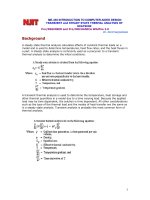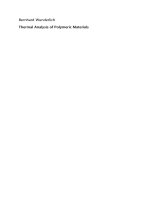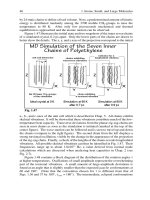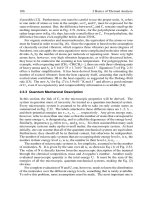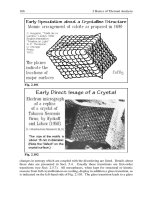Static and thermal analysis of piston and piston rings
Bạn đang xem bản rút gọn của tài liệu. Xem và tải ngay bản đầy đủ của tài liệu tại đây (851.94 KB, 8 trang )
<span class="text_page_counter">Trang 1</span><div class="page_container" data-page="1">
<b>51 </b> M.Srinadh, K. Rajasekhara Babu
<b> Static and Thermal Analysis of Piston and Piston Rings </b>
<b>M.Srinadh</b>
<b><sup>1</sup></b><b>, K. Rajasekhara Babu</b>
<b><sup>2</sup></b><small>1</small><b> M.Tech Student, Mechanical Engineering Dept, Bapatla Engineering Co llege, A.P, India </b>
<small>2</small> Assistanat. Professor, Mechanical Engineering Dept, Bapatla Engineering Co lle ge, A.P, India
<b>Abstract </b>
<i><b>A piston is a component of reciprocating engines, reciprocating pumps, compressors and pneumatic cylinders, among </b></i>
<i>other similar mechanisms. It is the moving component that is contained by a cylinder and is made gas-tight by piston rings. The piston transforms the energy of the expanding gasses into mechanical energy. The piston rides in the cylinder liner or sleeve. Pistons are commonly made of aluminum or cast iron alloys The present project to designed a piston for 1300cc diesel engine car and tak en 3 different profile rings .A 2D drawing is created from the calculations. The piston and piston rings are modeled using Pro/Engineer software, The stress and displacement are analyzed for the piston and piston rings by applying pressure on it in Structural analysis. By observing the analysis results, we can decide whether our designed piston is safe or not under applied load conditions. The thermal flux, thermal temperature distribution is analyzed by applying temperatures on the piston surface in Thermal analysis. </i>
<i>The structural and thermal analysis were also done on the piston and piston rings model using Cast iron, Aluminum Alloy A360 and Zamak . By comparing both the material analysis and decided which material is better for manufactur ing of Piston and piston rings. Structural and Thermal analysis were also performed in ANSYS software. </i>
<i><b>Key Words: </b></i>
<i><b>piston, piston rings, Struct ural analysis,thermal analysis, ANSYS</b></i><b>---***---1. INTRODUCTION TO PISTON </b>
<i>The piston transforms the energy of the expanding gasses </i>
into mechanical energy. The piston rides in the cylinder liner or sleeve. Pistons are commonly made of alu minum or cast iron alloys . To prevent the combustion gasses fro m bypassing the piston and to keep friction to a minimu m, each piston has several metal rings around it.These rings function as the seal between the piston and the cylinder wall and also act to reduce friction by minimizing the contact area between the piston and the cylinder wall. The rings are usually made of cast iron and coated with chrome or mo lybdenum. Most diesel engine pistons have several rings, usually 2 to 5, with each ring performing a distinct function. The top ring(s) acts prima rily as the pressure seal. The intermediate ring(s) acts as a wiper ring to re move and control the amount of oil film on the cylinder wa lls. The bottom ring(s) is an oiler ring and ensures that a supply of lubricatin g oil is evenly deposited on the cylinder wa lls
Ashwani Ku mar et al [1] The ma in objective of this research work is to investigate and analyze the stress distribution of piston at actual engine condition . M.afzaa lma lik et a l [2] The piston top ring in an automotive ring piston system plays a very crucial role during the engine start up and norma l operating conditions
<b>1.1 PISTON RINGS </b>
Piston rings are used on pistons to maintain gastight seals between the pistons and cylinders, to aid in cooling the piston, and to control cylinder-wa ll lubrication. About one-third of the heat absorbed by the piston passes through the rings to the cylinder wall. Piston rings are
often complicated in design, are heat treated in various ways, and are plated with other metals. Piston rings are of two distinct classificat ions: compression rings and oil control rings.
<b>1.2 MATERIALS FOR THE PISTON </b>
Cast Iron, Aluminu m Alloy and Cast Steel etc. are the common materia ls used for piston of an Internal Co mbustion Engine. Cast Iron p istons are not suitable for high speed engines due its more weight. These pistons have greater strength and resistance to wear.
The Aluminum A lloy Piston is lighter in weight and enables much lower running temperatures due to its higher thermal conductivity. The coeffic ient of e xpansion of this type of piston is about 20% less than that of pure alu minu m piston but higher than that of cast iron piston and cylinder wa ll. To avoid seizure because of higher e xpansion than cylinder wall, more piston clearance required to be provided. It results in piston slap after the engine is started but still warming up and tends to separate the crown fro m the skirt of the piston.
<b>2. MODELING 2.1 Design Calculations </b>
Density of diesel = 820 to 950 kg/cm at 15˚c = 0.00095 kg/c m³
Density = 0.00000095 kg/ mm³ Diesel C<small>10</small>H<small>22</small> to C<small>15</small>H<small>28</small> = C<small>15</small> H<small>28</small>Molecular weight of C<small>15</small>H<small>28</small> =208g/ mole Mass =density × volu me
m = 0.00000095× 312000 m =0.2964 kg
R = 8.3143 J/ mo l K
</div><span class="text_page_counter">Trang 2</span><div class="page_container" data-page="2"><b>52 </b> M.Srinadh, K. Rajasekhara BabuPV = m R T
P = 10.936 N/ mm²
<b>Piston He ad </b>
Gas pressure p = 10.936 N/ mm² Outside dia meter of p iston = 69.6 mm
σ<sub>t</sub> = bending tensile stress = 35-40MPa for cast iron Temperature at the centre of the piston head T<small>c</small> = 425˚c to 450˚c
Temperature at the edge of the piston head T<small>e</small> = 200˚c to 225˚c
T<small>c</small> – T<small>e</small> = 220˚c for cast iron Thickness of the ribs = to
or t<small>2</small> = 0.7 t<small>1</small> to t<small>1</small> = 1.645 to 2.35 mm
Width of top land b<small>1</small> = t<small>h</small> to 1.2 t<small>h</small> =15.75 to 18.9 mm The width of other ring land (distance between the ring grooves)
b<small>2</small> = 0.75t<small>2</small> to t<small>2</small> =1.74 to 2.32 mm
The gap between the free ends of the ring = 3.5t<small>1</small> to 4t<small>1</small> = 8.225 to 9.4 mm
<b>Piston Barrel (Cylindrica l portion of the Piston) </b>
Thickness of piston barrel
t<sub>3</sub> = radia l depth of piston ring groove b = t<sub>1</sub>+0.4 =2.75mm
L = length of the skirt +length of the ring section +top land
=55.68+16.24+18.9 = 90.82mm
d<small>0</small> = outside dia meter of the piston pin
l<small>1</small> =length of the piston pin in the bush of the small end of the connecting rod
= 0.45D = 0.45× 69.6 l<small>1</small>= 31.32mm
Load on the piston due to gas pressure p = 41585.951N
Load on the piston pin due to bearing pressure or bearing load = bearing pressure × bearing area
<b>2.2 2D DRAWINGS OF THE PISTON </b>
Fig 2.1 2D Drawing of the piston
Fig.2.2 showing the piston profile in Pro/E in step2
<b>3. ANALYSIS </b>
</div><span class="text_page_counter">Trang 3</span><div class="page_container" data-page="3"><b>53 </b> M.Srinadh, K. Rajasekhara Babu
<i>Static Analysis--Used to determine d isplacements, </i>
stresses, etc. under static loading conditions. Both linear and nonlinear static analyses, Nonlinearit ies can include plasticity, stress stiffening, large deflection, la rge strain, hyper elasticity, contact surfaces, and creep.
A <i>thermal analysis </i> calculates the temperature distribution and related therma l quantities in a system or component. Typical therma l quantities of interest are:
The temperature distributions The amount of heat lost or gained Thermal gradients
Thermal flu xes.
<b>3.1 MATERIAL PROPERTIES </b>
<b>Cast iron: </b>
Density -7.81 g/cm
<sup>3 </sup>Ultimate Tensile strength -900 MPa Yield tensile strength -600 MPa Modulus of elasticity -150 GPa
Specific heat -506J/kg-K Thermal conductivity -45W/m-K
<b>Aluminum A360: </b>
Density -2.65 g/cm
<sup>3 </sup>Ultimate Tensile strength -300MPa Yield tensile strength -180MPa Modulus of elasticity -71GPa
Specific heat -963J/kg-K Thermal conductivity -113W/m-K
<b>ZAMAK: </b>
Density -6.60 g/cm
<sup>3 </sup>Ultimate Tensile strength -240MPa Modulus of elasticity -96 GPa
Specific heat -420J/kg-K Thermal conductivity -113W/m-K
<b>3.2 BOUNDARY CONDITIONS: </b>
a) Temperature on piston head b) Convection on total body c) Pressure on piston head d) Constrained at piston pin holes
<b>4. RESULTS AND DISCUSSION </b>
Structural And Thermal Analysis Of Piston
<b>MATERIAL: CAS T IRON TOTAL DEFORMATION </b>
Fig 4.3 deformation with cast iron
Fro m fig 4.3 it shows the total deformation of the p iston is 0.00349mm.
<b>ELAS TIC STRAIN </b>
</div><span class="text_page_counter">Trang 4</span><div class="page_container" data-page="4"><b>54 </b> M.Srinadh, K. Rajasekhara BabuFig 4.4 strain with cast iron
<b>EQUIVALENT VON-MIS ES STRESS </b>
Fig 4.5 Distribution of von-mises stress
Fro m fig it can be found that the equivalent von -mises stress is 97Mpa.
<b>TEMPERATUR E </b>
Fig 4.6 Te mpe rature distribution with cast iron Fro m the fig te mperature distribution of the piston is determined. The ma ximu m te mperature is at the top of the piston is 450 <sup>0</sup>C.
<b>TOTAL HEAT FLUX </b>
Fig 4.7 Total heat flu x distribution
Fro m fig 4.7it can be found that the ma ximu m heat flu x is 8.3W/ mm<sup>2</sup>and the minimu m heat flu x is 1.02e<sup>-</sup><small>6</small>
By taking properties of Alu minu m and ZAMAK materia ls to piston head the analysis performed and results are plotted
<b>STRUCTARAL AND THERMAL ANALYS IS OF RECTANGULARFACE RING </b>
<b>MATERIAL:CASTIRON TOTAL DEFORMATION </b>
Fig 4.8 Deformation with cast ironFro m fig 4.8 the total deformat ion of the model can be determined. The ma ximu m and minimu m values are found to be MAX: 0.000768mm and MIN: 0.0000538mm
<b>ELAS TIC STRAIN </b>
Fig 4.9 strain with cast iron
</div><span class="text_page_counter">Trang 5</span><div class="page_container" data-page="5"><b>55 </b> M.Srinadh, K. Rajasekhara BabuFro m fig the strain values for cast iron model can be determined. It can be observed that the ma ximu m and minimu m va lues are MAX : 0.0008263 and min imu m values are MIN: 1.00e<sup>-4</sup>.
<b>EQUIVALENT VON-MIS ES STRESS </b>
Fig 4.10 Distribution of von-mises stress Fro m fig the stress values of cas t iron can be determined. It can be observed that the ma ximu m and minimu m values of stress are MAX: 90 Mpa and 11.06 Mpa.
<b>TEMPERATUR E </b>
Fig 4.11 Te mperature d istribution with
fro m the fig the te mperature distribution for cast iron can be determined. It can be found that the ma ximu m value of temperature occurs at the top of the ring of 320 <sup>0</sup>C.
<b>TOTAL HEAT FLUX </b>
<b>Fig 4.12 Total heat flu x distribution </b>
Fro m the fig total heat flu x of cast iron can be determined. The ma ximu m and min imu m values of heat flu x are found to be MAX: 7.67 W/ mm<sup>2</sup>
By taking properties of Alu minu m and ZAMAK materia ls to piston rings the analysis performed and results are plotted
<b>STRUCTARAL AND THERMAL ANALYS IS OF PIS TON </b>
Table . 4.1.1structaral and thermal analysis of piston DEFORM A
TION (mm)
STRAIN (mm/mm)
STRESS (Mpa)
HEAT FLUX (W/mm<sup>2</sup>) cast
iron <sup>0.00349 </sup> <sup>0.00191 </sup> <sup>97 </sup> <sup>8.3 </sup>Alumin
iu m A360
0.1282 0.00284 140 13.3 ZAMA
<b>ELAS TIC STRAIN: </b>
Table no .4.3 elastic strain of rings
<b>Strain(mm/ m</b>
Aluminu m
(A360) <sup>Zama k </sup>rectangular 0.000826 0.00132 9.53E-05 semi circular 0.00071 0.001 8.07E-05 Taper face 0.000687 0.00101 7.79E-05
<b>STRESS: </b>
Table no. 4.4 stress of rings
<b>Stress(Mpa) Cast Iron </b> Aluminu m (A360) Zama k
</div><span class="text_page_counter">Trang 6</span><div class="page_container" data-page="6"><b>56 </b> M.Srinadh, K. Rajasekhara Babu
<b>TOTAL HEAT FLUX </b>
Table no .4.5 total heat flu x of rings
<b>He at flux (w/ mm<sup>2</sup>) </b>
Cast Iron
Aluminu m (A360)
Zamak
semi circular 10.2 13 13.9 Taper face 8.47 10.05 10.9
<b>TOTAL DEFORMATION </b>
Graph no 4.1deformat ion vs different rings Graph no 4.1 illustrates the semic ircu lar face ring with za ma k accounted minimu m deformat ion
<b>ELAS TIC STRAIN </b>
Graph no 4.2 strain vs different rings Graph no 4.2 illustrates that minimu m strain of 0.8e<sup>-5</sup>
<b>accounted for semic ircular face ring with za ma k. </b>
<b>STRESS </b>
Graph no 4.3 stress vs different rings
Graph no 4.3 illustrates that minimu m stress of 72Mpa
<b>accounted for taper face ring with Alu min iu m. </b>
<b>TOTAL HEAT FLUX </b>
<b>TOTAL HEAT FLUX </b>
Graph no 4.4 total heat flu x vs diffe rent rings Graph no 4.4 illustrates that semic ircula r face ring with za ma k accounted ma ximu m heat flu x of 14 W/ mm<sup>2 </sup>
<b>STRUCTARAL AND THERMAL ANALYS IS OF PIS TON AND PIS TON RINGS </b>
<b>semi circular </b> 0.005294 0.00529 5.31E-03
<b>Taper face </b> 0.005313 0.005322 5.31E-03
<b>STRAIN </b>
Table no .4.7 elastic strain of piston and piston rings
<b>Strain (mm/mm) </b>
<b>Cast </b>
<b>Ir on Aluminum Zamak rectangul ar </b> 0.000385 0.000542 1.28E-04
<b>semi circular </b> 0.000434 0.000485 1.98E-04
<b>Taper face </b> 0.000799 0.00124 1.22E-04
<b>STRESS </b>
Table no. 4.8 stress of piston and pistonrings
<b>Stress (Mpa) </b> Cast Iron Aluminu m Zama k
</div><span class="text_page_counter">Trang 7</span><div class="page_container" data-page="7"><b>57 </b> M.Srinadh, K. Rajasekhara BabuTable no .4.9 total heat flu x of piston and pistonrings
<b>He at flux </b>
<b>(W/ mm<sup>2</sup>) </b> Cast Iron Aluminu m Zama k rectangular 7.7 9.76 10.34 semi circular 10.05 13.15 14 Taper face 10.5 11.2 11.85
<b>TOTAL DEFORMATION </b>
Graph no 4.5 defo rmation vs diffe rent rings Graph no 4.5 illustrates the rectangular face ring with A360 accounted min imu m deformation
<b>STRAIN </b>
Graph no 4.6 strain vs different rings Graph no 4.6 illustrates that minimu m strain of 0.00013 accounted for rectangular face ring with za ma k.
<b>STRESS </b>
Graph no 4.7 stress vs different rings
Graph no 4.7 illustrates that minimu m stress of 122Mpa accounted for semic ircular face ring with Alu miniu m TOTAL HEAT FLUX
<b>Gr aph no 4.8 total he at flux vs differe nt rings </b>
Graph no 4.8 illustrates that semic ircula r face ring with za ma k accounted ma ximu m heat flu x of 14 W/ mm<sup>2 </sup>
<b>4. CONCLUSIONS </b>
piston and Ring’s calculations are done for 1300cc diesel engine. Modeling of piston and Ring’s are prepared using parametric software creo(pro-engineer) and assembled. Assembly was e xported to Ansys work bench to conduct structural and therma l analysis. In the analysis piston and Ring’s were analy zed using 3 various materials Cast iron, Aluminu m(A 360) and Za mak.According to the results obtained from AnsysZamak materia l for piston is selected. In the analysis 3 different rings were analyzed using 3 various materia ls Cast iron, Alu minu m and Zama k.In 3 different ring profiles semicircular face ring is best as per the ansys results in deformations, strains and heat flu x. Za ma k is having lo w deformat ion and high heat flu x properties compare to other 2 materia ls. As per above results piston with Zama k is having high heat flux value than traditional materia ls. As per analyses values Zama k is having good value so we can use Zama k.
<b>REFERENCES </b>
[1]. Thermo -Mechanical and Vibrat ion Analysis of the I.C. Engine Piston made of Sic reinforced ZrB2 composite using Finite Ele ment Method (ANSYS) [2]. M. afzaa lma liket a l “Modeling of Piston Top Ring
Lubrication by considering Cylinder Roundness in Initial Engine Start up ”Proceedings of the World Congress on Engineering 2010 Vol II [3]. “Design, Analysis and Optimization of Three
Out-of-Aluminu m Piston Alloys Using FEA”
[4]. Mr. v.n. kongari“design and analysis of piston ring”International Conference on Mechanical & Industrial Eng ineering, 02nd June-2013, Bengaluru, [5]. R Mr.K.Kada mbanathan “Fatigue analysis of a diesel
piston ring by using FEA”Proceedings of the “National Conference on Emerging Trends In Mechanical Engineering 2k13”.
</div><span class="text_page_counter">Trang 8</span><div class="page_container" data-page="8"><b>58 </b> M.Srinadh, K. Rajasekhara Babu[6]. v. s. n. ch.dattu et al “Thermal Analysis on New
Piston Rings Face Profile” ISSN 2250-2459, ISO 9001:2008 Cert ified Journal, Volu me 4, Issue 3, March 2014)
[7]. K Ven kateswaraRao et a l “Modeling, Analysis and Optimization of Diesel Engine Piston”IJREAT International Journal of Research in Engineering & Advanced Technology, Volu me 2, Issue 1, Feb-Mar,
[8]. Dr. Ahe mad“Thermal Effects on Diesel EnginePiston andPiston Compression Rings” Eng&tech .journa l vol. 27 NOV 2009.
[9]. Automobile engineering by Dr.kirpalsingh vol.2 [10] I. C engines by v. ganeshan
</div>
